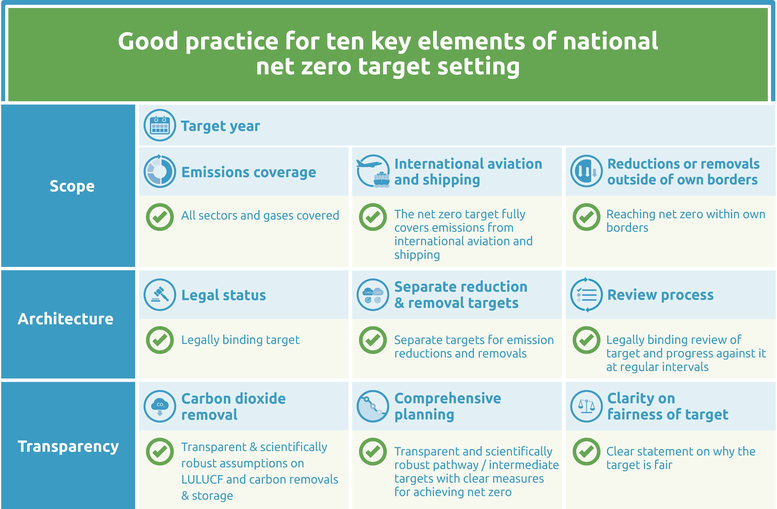Net zero targets
Summary
We evaluate the EU’s net zero target as: Acceptable.
In 2021, the European Union adopted its Climate Law, which enshrines its collective objective of achieving “climate neutrality by 2050.”
The EU’s climate neutrality - or, essentially, net zero GHG emissions – target is acceptable in terms of its architecture, transparency and scope, with a regular review and assessment process, a provision for the EU to set an intermediate target in 2040 following the Paris Agreement’s Global Stocktake, an exclusion of reductions or removals achieved outside of its territory, and clear analysis underpinning the target. A clear separation of the contributions from emissions reductions versus removals is missing, although this is an element that is required of the forthcoming 2040 target.
There is room for improvement in the target’s scope, as the European Climate Law currently does not clearly state that international aviation and maritime transport emissions are included, and an explanation of why net zero by 2050 constitutes a fair contribution is lacking.
The first assessment of the consistency of the EU’s climate policy and assessment of its progress towards its net zero target must be prepared by the Commission by 30 September 2023.
CAT analysis of net zero target
Ten key elements
Scope
- Target year – The EU aims to reach net zero GHG emissions by 2050 at the latest, with net negative emissions thereafter.
- Emissions coverage – The target covers all GHG emissions and all sectors of the economy.
- International aviation and maritime transport – While international aviation is included in the Commission’s modelling of the target, maritime transport is not. The inclusion of the international aviation and maritime transport is also not clearly mentioned in the European Climate Law.
- Reductions or removals outside of own borders – The Climate Law states that the balance between emissions and removals is to be achieved domestically.
Target architecture
- Legal status – The EU included its net zero target in its Climate Law passed in 2021 (European Parliament and Council). Additionally, the net zero target is included in the EU’s LTS (Croatian Presidency and the European Commission, 2020).
- Separate reduction & removal targets – The EU currently does not provide separate emissions reduction and removal targets as part of its net zero target. However, when the Commission proposes a 2040 target following the Global Stocktake, it will also provide a projected indicative greenhouse gas budget for the period 2030-2050, with separate information on emissions and removals (European Parliament & Council of the European Union, 2021).
- Review process – The EU Climate Law includes a legally binding process for the Commission to report on the operation of the regulation within six months of each Global Stocktake (Article 9a). When it does so, the Commission may include proposals for amendments to the regulation.
There is also a provision on the tracking of collective progress of the EU towards the achievement of net zero (Article 5). This assessment will be made every five years, following the five-yearly cycles of the Paris Agreement, and will track progress against a linear emissions trajectory from 2030 to 2050, via 2040 once this target has been set.
The Commission will also assess the consistency of measures put in place by member states with the net zero objective (Article 6). In accordance with the Paris Agreement timelines, the Commission will review the EU trajectory every five years. In doing so, it will regularly assess whether any updating of the trajectory is required and take action in case of insufficient progress. The Law also established European Scientific Advisory Board on Climate Change whose advise must be taken into account when specifying the EU’s indicative greenhouse gas budget for the period 2030–2050.
Transparency
- Carbon dioxide removal – The European Commission’s supporting analysis for its climate neutral strategy provides an analysis of two scenarios for achieving climate neutrality by 2050, with transparent assumptions on the contributions from technological CDR options and LULUCF in each pathway for LULUCF and for removals and storage. LULUCF sinks are distinguished and treated transparently throughout the strategy (European Commission, 2018).
- Comprehensive planning – The Climate Law has set an intermediate target of a GHG emissions reduction of 55% by 2030 (below 1990 levels), and requires a 2040 target and projected emissions budget for 2030-2050 to be provided by the Commission following the first Global Stocktake under the Paris Agreement. The Commission’s underlying analysis for the climate neutrality strategy identifies clear pathways and key measures for reaching net zero, with sector-specific detail, albeit presenting two alternative scenarios.
- Clarity on fairness of target – The EU refers to the social fairness of the appropriate measures and fairness between member states but makes no reference to global fairness or equity in the context of its net zero target.
Good practice
The Climate Action Tracker has defined the following good practice for all ten key elements of net zero targets. Countries can refer to this good practice to design or enhance their net zero targets.
Further analysis
Latest publications
Stay informed
Subscribe to our newsletter





